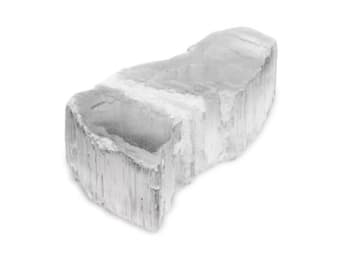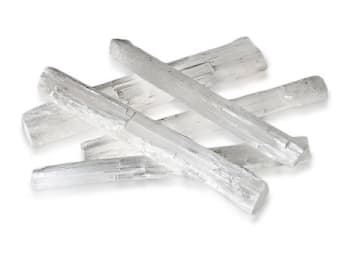Gypsum is a mineral that has been utilized since antiquity. This soft mineral represents the second level on the Mohs hardness scale. Cut stones are rare because gypsum has perfect cleavage, and it is too soft to facet. The fine-grained variety known as alabaster is used for carvings and decorative objects. Selenite is the large crystalline variety that is popular with mineral collectors. The fibrous variety is known as satin spar. Gypsum sometimes crystallizes in rosette patterns known as desert roses. Gypsum is probably best known for its use in construction materials like sheetrock, cement, and plaster.
General Information
LWUV: Typically yellowish white but can be green, greenish white, yellowish white, bluish white, pale yellow, orange yellow
Gypsum Colors
-
 Black
Black -
 Blue
Blue -
 Brown
Brown -
 Colorless
Colorless -
 Gray
Gray -
 Pink
Pink -
 White
White -
 Yellow
Yellow
Alternate Names
Alabaster, Desert Rose, Gypsite, Satin Spar, Selenite
Countries of Origin
Papua New Guinea; Angola; Sudan; Kazakhstan; Paraguay; Portugal; Bahamas; Moldova (the Republic of); Solomon Islands; Greece; Latvia; Mongolia; Morocco; Unknown; Panama; Chile; Argentina; Isle of Man; Ukraine; Zambia; India; Canada; Turkey; Belgium; Namibia; Finland; South Africa; Georgia; Peru; Turkmenistan; Venezuela (Bolivarian Republic of); Germany; Yemen; Tanzania, United Republic Of; Eritrea; Fiji; Madagascar; Thailand; Kiribati; Libya; Costa Rica; Sweden; Liechtenstein; Poland; Jordan; Tunisia; Palestine, State of; Croatia; Syrian Arab Republic; Tuvalu; United Arab Emirates; Kenya; Switzerland; Spain; Djibouti; Lebanon; Azerbaijan; Cuba; Mauritania; Saint Lucia; Australia; Tajikistan; Estonia; Myanmar; Cyprus; Malaysia; Iceland; Oman; Bosnia And Herzegovina; Armenia; Austria; Mozambique; Korea (the Republic of); Luxembourg; Brazil; Algeria; Slovenia; Colombia; Ecuador; Hungary; Japan; Taiwan (Province of China); Albania; Bolivia (Plurinational State of); Lao People's Democratic Republic; Trinidad And Tobago; New Zealand; Vanuatu; Senegal; Italy; Antarctica; Ethiopia; Afghanistan; Russian Federation; Czechia; United States of America; Egypt; Malta; Saudi Arabia; Netherlands; Pakistan; China; Ireland; Qatar; Slovakia; France; Lithuania; Serbia; Kyrgyzstan; Bhutan; Romania; Niger; Philippines; Uzbekistan; Barbados; Nicaragua; Norway; Botswana; Denmark; Dominican Republic; Mexico; Zimbabwe; Greenland; Montenegro; Indonesia
Care
Due to its soft nature gypsum needs to be kept away from harder materials that will damage its surface. Gypsum will turn cloudy if exposed to heat.
Species/Variety
Alabaster
Alabaster is a fine-grained massive form of gypsum. Alabaster ranges from white to yellow, pink, and brown. Due to its porosity it is often dyed. It has been used for centuries for statues, carvings, and other ornamental purposes. Treated alabaster is used as a marble simulant. Due to its extreme softness, it is ideal for fashioning into works of art.
Satin Spar
Satin spar is an adjective used when the fibrous habit of a mineral gives it a satin luster. The term satin spar has been used in the past to describe calcite and aragonite; however, it is currently accepted as one variety of the mineral gypsum, along with selenite and alabaster.
Tolerance:(+0.001/-0.001)
LWUV: Inert to weak brownish to greenish white
Desert Rose
When gypsum forms in rose like patterns it is called a desert rose. They are found in desert regions where liquid containing gypsum evaporates leaving the gypsum to crystallize. Gypsum roses can be distinguished from barite roses by their sharp edges. Desert roses from Chihuahua, Mexico have distinctive white edges.
Selenite
Selenite is the name for transparent, colorless to near colorless crystals of gypsum, a hydrous calcium sulfate that is found in a number of forms. The name "selenite" comes from the Greek word selene, meaning "moon", no doubt in reference to the gem's white glow. Gypsum, in all varieties, is very soft and has perfect cleavage so it should be handled with care.




